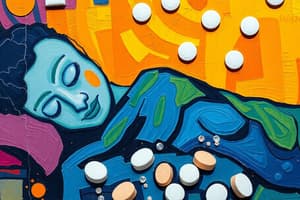Podcast
Questions and Answers
What is the primary aim of treatment for insomnia?
What is the primary aim of treatment for insomnia?
- To completely eliminate the use of sleep medications
- To improve the patient's sleep quality and daytime functioning (correct)
- To eliminate all sleep disturbances
- To help patients fall asleep quickly
Which of the following is a classification of insomnia?
Which of the following is a classification of insomnia?
- Persistent
- Transient (correct)
- Intermittent
- Acute
Which of the following is NOT an exclusion criteria for self-treatment with OTC medications?
Which of the following is NOT an exclusion criteria for self-treatment with OTC medications?
- Insomnia related to mental health conditions
- Insomnia related to substance use
- Insomnia related to underlying medical conditions
- Symptoms lasting more than 2 weeks (correct)
What is the main goal of insomnia treatment based on the provided content?
What is the main goal of insomnia treatment based on the provided content?
What does the abbreviation OTC stand for in the context of "Exclusion Criteria for Self-Treatment with OTC Medications"?
What does the abbreviation OTC stand for in the context of "Exclusion Criteria for Self-Treatment with OTC Medications"?
Flashcards
Insomnia Treatment Goals
Insomnia Treatment Goals
Objectives set to alleviate the symptoms of insomnia and improve sleep quality.
Transient Insomnia
Transient Insomnia
A short-term form of insomnia typically lasting from a few days to a few weeks.
Classification of Insomnia
Classification of Insomnia
Categories that classify insomnia based on duration and severity, such as transient, short-term, and chronic.
OTC Medication Exclusion Criteria
OTC Medication Exclusion Criteria
Signup and view all the flashcards
Self-Treatment Guidelines
Self-Treatment Guidelines
Signup and view all the flashcards
Study Notes
Insomnia Classifications
- Transient insomnia lasts less than one week
- Short-term insomnia lasts less than three months
- Chronic insomnia lasts more than three months
Exclusion Criteria for OTC Insomnia Medications
- Under 12 years old
- Over 65 years old
- Pregnant or breastfeeding
- Insomnia lasting more than 10 days
Stages of Sleep
- Stage 1: Transitional stage, occurs as the person falls asleep. Light sleep, about 50% of total sleep.
- Stage 2: Deeper sleep; sleepwalking, talking, nightmares, and bedwetting may occur.
- Stages 3 & 4: Neither light nor deep sleep. Skeletal muscle movement is inhibited. Not as much deep sleep as stage 2.
- REM Sleep: Rapid eye movement sleep. Eyes move rapidly side to side. High levels of brain activity, vivid dreams. Blood pressure, heart rate, temperature and metabolism increase. Repeats every 90-120 minutes.
Onset and Duration of Sleep Stages
- Onset of sleep is typically within seconds to minutes, lasting 5-10 minutes.
- Time spent in each stage varies. Stage 2 is most frequent while sleeping. REM periods increase in length as the cycle progresses, with the final REM stage lasting up to an hour.
Diseases and Medications Associated with Insomnia
- Allergies, asthma, COPD
- Alcohol abuse
- Anxiety, depression
- Arthritis, chronic pain
- Antidepressants (e.g., bupropion, fluoxetine, venlafaxine)
- Benign prostatic hyperplasia
- Antihypertensives (e.g., clonidine)
- Gastroesophageal reflux disease
- Amphetamines
- Heart failure
- Beta-adrenergic agonists (e.g., albuterol)
- Menopause
- Caffeine
- Obstructive sleep apnea
- Corticosteroids
- Pregnancy
- Decongestants
- Restless leg syndrome
- Diuretics (taken at bedtime)
- Shift-work sleep disorder
Pharmacologic Therapy for Insomnia
- Diphenhydramine: 25 or 50 mg, 30 minutes before bedtime.
- Melatonin: 2 to 10 mg, 30-60 minutes before bedtime.
Mechanism of Action of Diphenhydramine and Melatonin
- Diphenhydramine blocks histamine-1 receptors
- Melatonin regulates the sleep-wake rhythm by acting on melatonin receptors
Common Side Effects of Diphenhydramine and Melatonin
- Diphenhydramine: Dry mouth/throat, constipation, blurred vision, difficulty urinating, tinnitus.
- Melatonin: Dizziness, drowsiness, headache, nausea.
Non-Pharmacological Strategies for Insomnia
- Cognitive Behavioral Therapy (CBT-I): First-line treatment for insomnia. Addresses dysfunctional thoughts and behaviors.
- Sleep Hygiene: Establish regular sleep schedule, create a comfortable sleep environment, avoid caffeine and alcohol before bedtime, and limit daytime naps. Avoid screens before bed.
Therapeutic Considerations for Insomnia Medication
- Monitor patients for 3 nights of improved sleep.
- Stop medication for one night to assess effectiveness.
- Limit use to 7-10 consecutive nights.
- Doxylamine may be used but is not recommended for a lack of support for its efficacy in studies.
- Melatonin is relatively safe in adults (8mg daily up to 6 months, 10mg daily up to 2 months).
- Melatonin may be safe and possibly effective for insomnia, but clinical significance is sometimes limited.
- Consultation with a doctor is recommended when using medication for insomnia.
Insomnia Management Algorithm (Flow Chart)
- Initial Assessment: Confirm exclusion criteria and sleep problems, then assess for underlying issues like sleep hygiene.
- Difficulty falling asleep: Assess for other causes like stimulants, underlying conditions.
- Rested in the morning? If the patient feels rested and functional during the day, assess if stimulants are contributing to the issue.
- Problem related to stimulants / lifestyle? If identified as a factor, cessation/moderation should be suggested. If lifestyle or stress is the issue, then sleep hygiene and CBT-I should be encouraged.
- Insomnia resolved? If yes, the medication/treatment plan is effective. If not, consult a doctor, and continue to address underlying issues.
Studying That Suits You
Use AI to generate personalized quizzes and flashcards to suit your learning preferences.




